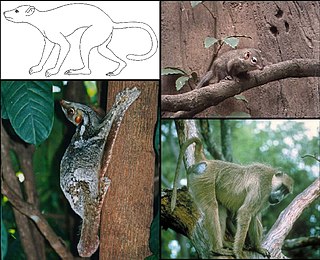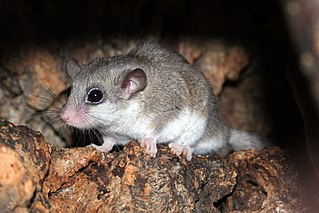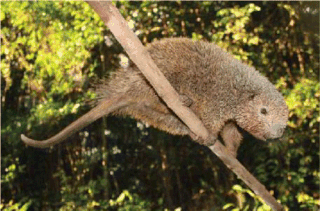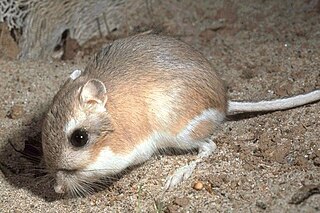
Xenarthra (Latin, from Ancient Greek ξένος + ἄρθρον is a superorder of placental mammals found in the Americas. It currently consists of anteaters, tree sloths, and armadillos. Xenarthrans originated in South America during the Paleocene about 59 million years ago. They evolved and diversified extensively in South America during the continent's long period of isolation in the early to mid Cenozoic Era. They spread to the Antilles by the early Miocene and, starting about 3 Mya, spread to Central and North America as part of the Great American Interchange. Nearly all of the formerly abundant megafaunal xenarthrans, such as ground sloths, glyptodonts, and pampatheres, became extinct at the end of the Pleistocene.

Multituberculata is an extinct taxon of rodent-like allotherian mammals that existed for approximately 166 million years, the longest fossil history of any mammal lineage. They eventually declined from the late Palaeocene onwards, disappearing in the late Eocene, though they might have lived even longer into the Miocene, if gondwanatheres are part of this group. More than 200 species are known, ranging from mouse-sized to beaver-sized. These species occupied a diversity of ecological niches, ranging from burrow-dwelling to squirrel-like arborealism to jerboa-like hoppers. Multituberculates are usually placed as crown mammals outside either of the two main groups of living mammals—Theria, including placentals and marsupials, and Monotremata—but closer to Theria than to monotremes.

The family Castoridae contains the two living species of beavers and their fossil relatives. This was once a highly diverse group of rodents, but is now restricted to a single genus, Castor.

The Euarchonta are a proposed grandorder of mammals containing four orders: the Scandentia or treeshrews, the Dermoptera or colugos, the extinct Plesiadapiformes, and the Primates.

Ailuridae is a family in the mammal order Carnivora. The family consists of the red panda and its extinct relatives.

The Eumuroida are a clade defined in 2004 by Steppan et al. to describe a group of muroid rodents. The clade is not defined in the standard taxonomic hierarchy, but it is between superfamily and family.

Glires is a clade consisting of rodents and lagomorphs. The hypothesis that these form a monophyletic group has been long debated based on morphological evidence. Two morphological studies, pubished in 2001 and 2003, strongly support the monophyly of Glires. In particular, the 2003 study, reported the discovery of fossil material of basal members of Glires, particularly the genera Mimotona, Gomphos, Heomys, Matutinia, Rhombomylus, and Sinomylus. Their description, in 2005, helped to bridge the gap between more typical rodents and lagomorphs. Data published in 2001, based on nuclear DNA, supported Glires as a sister of Euarchonta to form Euarchontoglires, but some genetic data from both nuclear and mitochondrial DNA have been less supportive. A study, published in 2007, investigating retrotransposon presence/absence data unambiguously supports the Glires hypothesis. Studies published in 2011 and 2015, place Scandentia as a sister clade of the Glires, invalidating Euarchonta as a clade.

Simplicidentata is a group of mammals that includes the rodents and their closest extinct relatives. The term has historically been used as an alternative to Rodentia, contrasting the rodents with their close relatives the lagomorphs. However, Simplicidentata is now defined as including all members of Glires that share a more recent common ancestor with living rodents than with living lagomorphs. Thus, Simplicidentata is a total group that is more inclusive than Rodentia, a crown group that includes all living rodents, their last common ancestor, and all its descendants. Under this definition, the loss of the second pair of upper incisors is a synapomorphic feature of Simplicidentata. The loss of the second upper premolar (P2) has also been considered as synapomorphic for Simplicidentata, but the primitive simplicidentate Sinomylus does have a P2.

The bristle-spined rat is an arboreal rodent from Brazil. Also known as the bristle-spined porcupine or thin-spined porcupine, it is the only member of the genus Chaetomys and the subfamily Chaetomyinae. It was officially described in 1818, but rarely sighted since, until December 1986, when two specimens - one a pregnant female - were found in the vicinity of Valencia in Bahia.

Geomyoidea is a superfamily of rodent that contains the pocket gophers (Geomyidae), the kangaroo rats and mice (Heteromyidae), and their fossil relatives.

The term Hystricomorpha has had many definitions throughout its history. In the broadest sense, it refers to any rodent with a hystricomorphous zygomasseteric system. This includes the Hystricognathi, Ctenodactylidae, Anomaluridae, and Pedetidae. Molecular and morphological results suggest the inclusion of the Anomaluridae and Pedetidae in Hystricomorpha may be suspect. Based on Carleton & Musser 2005, these two families are treated here as representing a distinct suborder Anomaluromorpha.

Cimolesta is an extinct order of non-placental eutherian mammals. Cimolestans had a wide variety of body shapes, dentition and lifestyles, though the majority of them were small to medium-sized general mammals that bore superficial resemblances to rodents, weasels or opossums.

The rodent family Diatomyidae, found in Asia, is represented by a single known living species, Laonastes aenigmamus.
Diatomys is an extinct rodent genus known from Miocene deposits in China, Japan, Pakistan, and Thailand. The fossil range is from the late Early Miocene to the Middle Miocene.

Eomyidae is a family of extinct rodents from North America and Eurasia related to modern day pocket gophers and kangaroo rats. They are known from the Middle Eocene to the Late Miocene in North America and from the Late Eocene to the Pleistocene in Eurasia. Eomyids were generally small, but occasionally large, and tended to be squirrel-like in form and habits. The family includes the earliest known gliding rodent, Eomys quercyi.
Eurymylidae is a family of extinct simplicidentates. Most authorities consider them to be basal to all modern rodents and may have been the ancestral stock whence the most recent common ancestor of all modern rodents arose. However, the more completely known eurymylids, including Eurymylus, Heomys, Matutinia, and Rhombomylus, appear to represent a monophyletic side branch not directly ancestral to rodents. Huang et al. (2004) have argued that Hanomys, Matutinia, and Rhombomylus form a clade characterized by distinctive features of the skull and dentition that should be recognized as a separate family, Rhombomylidae. Eurymylids are only known from Asia.
Cephalomyidae is an extinct family of caviomorph rodents from South America. The specific relationships of the family are uncertain, and affinities to both chinchilloid and cavioid rodents have been supported. Most recently, Kramarz (2005) performed a phylogenetic analysis supporting a relationship to the Cavioidea, as represented by Eocardiidae. McKenna and Bell (1997) questioned the validity of the family, placing the cephalomyid genera then known in Dasyproctidae, but Kramarz (2001) subsequently reasserted the distinctiveness of cephalomyids. Fossils of the family have been found in Deseadan to Colhuehuapian Fray Bentos, Deseado, Cerro Bandera and Sarmiento Formations and the Colhué Huapí Member of Argentina and the Puca Group of Bolivia.

Mesotheriidae is an extinct family of notoungulate mammals known from the Eocene through the Pleistocene of South America. Mesotheriids were small to medium-sized herbivorous mammals adapted for digging.
The Deseadan age is a period of geologic time within the Oligocene epoch of the Paleogene to the Early Miocene epoch of the Neogene, used more specifically within the SALMA classification of South America. It follows the Tinguirirican and precedes the Colhuehuapian age.
Vilevolodon is an extinct, monotypic genus of volant, arboreal euharamiyids from the Oxfordian age of the Late Jurassic of China. The type species is Vilevolodon diplomylos. The genus name Vilevolodon references its gliding capabilities, Vilevol, while don is a common suffix for mammalian taxon titles. The species name diplomylos refers to the dual mortar-and-pestle occlusion of upper and lower molars observed in the holotype; diplo, mylos.
















